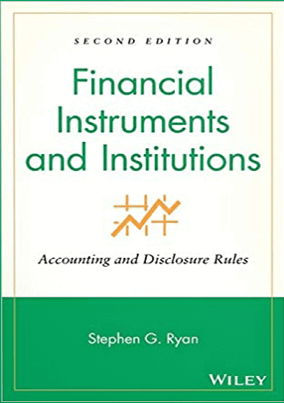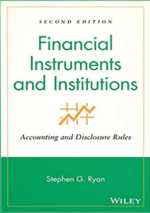Over the years, financial professionals around the world have looked to the Wiley Finance series and its wide array of bestselling books for the knowledge, insights, and techniques that are essential to success in financial markets.
Stephen G.Ryan – Financial Instruments & Institutions (2nd Ed.)
Description
The most authoritative guide on understanding the accounting and disclosure rules involved when dealing with financial instruments
This book examines the main accounting and disclosure rules for financial and risk disclosures in the analysis of instruments and institutions, such as thrifts, mortgage banks, commercial banks, lessors, and property-casualty and life insurers, and financial instruments. It focuses on the essential roles of fair value accounting for financial instruments. Particularly important Statements of Financial Accounting Standards(SFAS) are discussed in detail.
Stephen G. Ryan (New York, NY) is an Associate Professor of Accounting and Peat, Marwick Faculty Fellow at the Stern School of Business at New York University.
Over the years, financial professionals around the world have looked to the Wiley Finance series and its wide array of bestselling books for the knowledge, insights, and techniques that are essential to success in financial markets. As the pace of change in financial markets and instruments quickens, Wiley Finance continues to respond. With critically acclaimed books by leading thinkers on value investing, risk management, asset allocation, and many other critical subjects, the Wiley Finance series provides the financial community with information they want. Written to provide professionals and individuals with the most current thinking from the best minds in the industry, it is no wonder that the Wiley Finance series is the first and last stop for financial professionals looking to increase their financial expertise.
ABOUT THE AUTHOR
Stephen G. Ryan is an Associate Professor of Accounting and Robert Stovall Faculty Fellow at the SternSchool of Business, New York University. Prior to that position, he was an assistant professor of accounting at the Yale School of Organization and Management and has been an associate consultant with Bain & Company. He has written numerous articles that have appeared in such publications as Accounting Horizons, Financial Analysts Journal, the Accounting Review, and the Journal of Financial Statement Analysis. He is an Editor of the Review of Accounting Studies. In addition, he is on the FASB’s Financial Institutions Advisory Group and its Liabilities and Equity Resource Group.
Download immediately Stephen G.Ryan – Financial Instruments & Institutions (2nd Ed.)
TABLE OF CONTENTS
Preface ix
Acknowledgments xvii
Chapter 1 Financial Instruments and Institutions 1
Main Ingredients of the Analysis of Financial Instruments 4
Activities and Risks of Financial Institutions 11
Valuation of Financial Institutions in Practice 16
Chapter 2 Nature and Regulation of Depository Institutions 19
Activities of Depository Institutions 19
Bank Regulation 22
Bank Subtypes 35
Recent Trends 38
Chapter 3 Thrifts 45
Financial Statement Structure 46
Main Risk-Return Trade-Offs and Financial Analysis Issues 56
Chapter 4 Interest Rate Risk and Net Interest Earnings 63
Views of Interest Rate Risk 64
Interest Rate Risk Concepts 66
Analysis of Net Interest Earnings 78
Rate-Volume Analysis 81
Repricing Gap Disclosures 84
Chapter 5 Credit Risk and Losses 93
Economics of Credit Risk 95
Accounts for Loans and Loan Losses 97
Accounting and Disclosure Rules for Unimpaired Loans 100
Accounting and Disclosure Rules for Impaired Loans 107
Loan Portfolio Quality and Loan Loss Reserve Adequacy 110
Research on Banks’ Loan Loss Reserves 118
Appendix 5A: SunTrust Banks—After the Restatement 119
Chapter 6 Fair Value Accounting for Financial Instruments: Concepts, Disclosures, and Investment Securities 131
Fair Value Accounting for Financial Instruments 133
Disclosures of the Fair Value of Financial Instruments 141
Investment Securities 149
Appendix 6A: Washington Federal’s Big Gap 158
Chapter 7 Mortgage Banks 161
Mortgage Banking Industry, Major Players, and Activities 162
Financial Statement Structure 167
Main Risk-Return Trade-Offs and Financial Analysis Issues 174
Accounting for Fees and Costs 186
Chapter 8 Securitizations 189
Why and What? 192
Securitization Structures 196
SFAS No. 140 204
Financial Analysis Issues 216
Empirical Research on Securitizations 221
Servicing Rights and Prepayment-Sensitive Securities 222
Appendix 8A: Doral Financial’s Interesting Interest-Only Strips 224
Chapter 9 Elements of Structured Finance Transactions 235
Special-Purpose/Variable-Interest Entities 236
Related Transactions 244
Hybrid Financial Instruments 248
Financial Guarantees 251
Recent SEC Decisions Regarding Structured Finance Transactions 253
Chapter 10 Commercial Banks 255
Balance Sheet 257
Income Statement 261
Cash Flow Statement 265
Chapter 11 Derivatives and Hedging 269
Derivatives 272
Hedging 282
SFAS No. 133 (1998), as Amended 285
Framework for Assessing Financial Institutions’ Derivatives and Hedging 308
Chapter 12 Market Risk Disclosures 311
Overview of FRR No. 48 (1997) 312
Tabular Format 315
Sensitivity Approach 322
Value-at-Risk Approach 326
Comparison of Disclosure Approaches 331
Effect of SunTrust’s Derivatives and Hedging on Its Market Risk 332
Research 337
Appendix 12A: Bank of America’s Derivatives, Hedging, and Market Risk 337
Chapter 13 Lessors and Lease Accounting 347
Competitive Advantages of Leasing 350
Lease Structures and Contractual Terms 352
Lessors’ Risks 355
Lease Accounting Methods 357
Analysis Issues Regarding Lease Accounting Methods 366
Special Lease Transactions 369
Lessors’ Financial Statements 374
Lease Disclosures 379
Possible Future Changes in Lease Accounting 387
Chapter 14 Insurers and Insurance Accounting 389
Products 391
Risk-Return Trade-Offs 396
Regulation 403
Primary Insurance Accounting Standards 405
Accounting Standards Governing Embedded Derivatives and Other Life Insurance Policy Features 421
Financial Statements 423
Line of Business Disclosures 428
Other Insurance Accounting Systems 429
Chapter 15 Property-Casualty Insurers’ Loss Reserve Disclosures 435
Loss Reserve Footnote 438
Loss Reserve Development Disclosures 440
Calculating Loss Reserves by Accident Year 444
Calculating Loss Reserve Revisions by Accident Year 446
Calculating Claim Payments by Accident Year and Tail 448
Constructing Accident Year Loss Reserve T Accounts 452
Property-Casualty Expense Ratios 453
Chapter 16 Reinsurance Accounting and Disclosure 457
Accounting and Analysis Issues 459
Reinsurance Contracts 462
Accounting for Reinsurance Contracts 472
Reinsurance Disclosures and Analysis 487
Evolution of Financial Reporting for Reinsurance 493
Index 497








